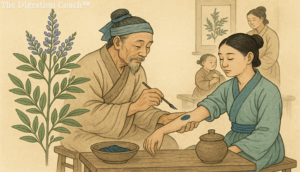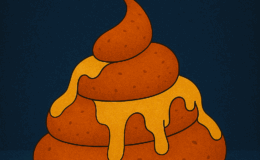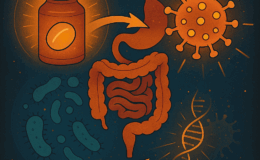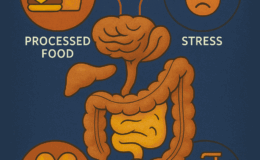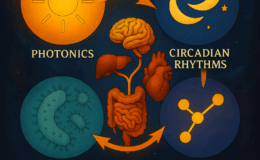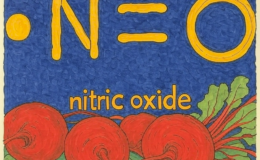Ulcerative colitis (UC), a chronic inflammatory bowel disease (IBD), affects millions, causing symptoms like abdominal pain and diarrhea. Current treatments, such as steroids and immunosuppressants, often face challenges like low responsiveness and high recurrence. However, a groundbreaking study in iMeta (Xing et al., 2025) focuses a lens on indigo as a novel UC therapy. It’s a microbiota-driven approach using indigo, a component of indigo naturalis, to combat ulcerative colitis. This post explores how indigo, as a novel UC therapy, leverages gut microbiota, Roseburia intestinalis, the short chain fatty acid (SCFA) butyrate, Th17/Treg cells, CD4⁺ T cell regulation, and mTOR signaling to offer hope for UC patients.
The Gut Microbiota: Powerhouse for UC Treatment
The gut microbiota, a vibrant ecosystem of trillions of microbes, supports the intestinal barrier and immune balance. In UC, dysbiosis disrupts these functions, fueling inflammation. The iMeta study shows that indigo, as a novel UC therapy, restores microbial balance, increasing diversity and shifting the Firmicutes-to-Bacteroidetes ratio. Indigo enriches beneficial bacteria like Roseburia while reducing harmful ones like Bacteroides. Depleting microbiota with antibiotics abolished indigo’s benefits, but fecal transplants from indigo-treated mice restored them, confirming the gut’s role in this therapy.
Roseburia intestinalis: The Microbial Hero
Indigo directly promotes this butyrate-producing bacterium, which protects the gut. In colitis mice, Roseburia colonization mirrored indigo’s effects, reducing inflammation and balancing immunity. In UC patients, low Roseburia levels correlated with worse disease severity, highlighting its relevance. Butyrate, a short chain fatty acid (SCFA) is Roseburia’s key metabolite. Butyrate strengthens the gut barrier and modulates immune responses, making it central to indigo’s therapeutic potential as a UC therapy. .
Butyrate and Immunity: Balancing Th17/Treg Cells
CD4⁺ T cells, which differentiate into pro-inflammatory Th17 or regulatory Treg cells, are critical in UC. Th17 cells drive inflammation, while Treg cells promote tolerance. Indigo as a novel UC therapy improves this Th17/Treg balance, reducing Th17 cells and boosting Treg cells, as shown in colitis mice. Butyrate, increased by indigo, mediates this effect by regulating CD4⁺ T cell differentiation. In vitro, butyrate lowered Th17 numbers and enhanced Treg cells, reprogramming glucose metabolism to curb inflammation.
mTORC1/HIF-1α: The Molecular Key
Butyrate’s effects hinge on the mTORC1/HIF-1α pathway, which regulates Th17 differentiation via glycolysis. The iMeta study found that butyrate suppresses mTORC1 and HIF-1α, inhibiting Th17 cells. This was reversed by an mTORC1 agonist, confirming the pathway’s role. A 2020 study in Journal of Immunology Research noted that mTOR inhibitors could treat T cell-associated inflammation, suggesting that mTORC1 inhibitors like rapamycin may reduce Th17-driven inflammation in IBD models, supporting indigo’s mechanism.
Why Indigo as a Novel UC Therapy Matters
Indigo novel UC therapy stands out by targeting the gut-immune axis, addressing limitations of conventional treatments. In mice, oral indigo (60 mg/kg) reduced inflammation, and in UC patients, low Roseburia and butyrate correlated with disease severity. A 2018 trial in Gastroenterology showed indigo naturalis improved UC remission, though safety concerns remain. By focusing on butyrate and microbiota, indigo as a novel UC therapy offers a safer, targeted approach.
Broad Implications and Future Directions
Beyond UC, indigo’s effects may apply to Crohn’s disease or rheumatoid arthritis, where Th17/Treg imbalances occur. A 2022 EBioMedicine study noted Roseburia’s role in Crohn’s. Future research should explore clinical trials for indigo, personalized microbiota profiles, and combination therapies with probiotics such as Lactobacillus rhamnosus GG (LGG). Understanding butyrate’s other mechanisms, like histone deacetylase inhibition, could further enhance indigo as a novel UC therapy.
Conclusion
Indigo, as a novel UC therapy, driven by gut microbiota and butyrate, redefines UC treatment options. By promoting Roseburia, regulating CD4⁺ T cells, and modulating the mTORC1/HIF-1α pathway, indigo offers a personalized, microbiota-driven solution. As research advances, indigo as a novel UC therapy could transform IBD management, bringing hope to millions. Stay tuned for more on this gut-health revolution!
References:
– Xing, Y., et al. (2025). Gut microbiota-derived butyrate mediates the anticolitic effect of indigo supplementation through regulating CD4⁺ T cell differentiation. iMeta, e70040.
– Naganuma, M., et al. (2018). Efficacy of indigo naturalis in a multicenter randomized controlled trial of patients with ulcerative colitis. Gastroenterology, 154(4), 935-947.
– Shen, Z., et al. (2022). Roseburia intestinalis stimulates TLR5-dependent intestinal immunity against Crohn’s disease. EBioMedicine, 85, 104285.
– Wang, P., et al. (2020). The regulatory effects of mTOR complexes in the differentiation and function of CD4+ T cell subsets. Journal of Immunology Research, 2020, 3406032.
COMPLIMENTARY 15-MINUTE CALL
Take your first step toward a renewed sense of well-being. Call today to arrange a complimentary 15-minute consultation.
Let’s discern whether my approach aligns with your needs.
I look forward to connecting with you at 714-639-4360.

